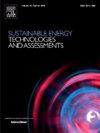An overview of open field agrivoltaic systems: A comprehensive description of combination of agricultural and energy production
IF 7.1
2区 工程技术
Q1 ENERGY & FUELS
Sustainable Energy Technologies and Assessments
Pub Date : 2025-06-02
DOI:10.1016/j.seta.2025.104369
引用次数: 0
Abstract
This overview aims to gather current knowledge and present recent findings in the field of agrivoltaic systems in a comprehensive manner. The impact of open field agrivoltaic systems on crop yields under different conditions is presented, as well as the factors that cause the mentioned impacts. Moreover, factors shaping beneficial effects of agrivoltaic are indicated. This paper also demonstrates the results of studies related to the effect of the systems in question on evapotranspiration and local microclimate. Challenges connected with the selection of adjacent plants for agrivoltaic installations are underscored. Furthermore, parameters aiming to describe agrivoltaic systems, commonly used in current works, are presented and explained. Since the layout and, consequently, the arrangement of the systems under discussion impact directly on the yield of crops, recently proposed layouts were demonstrated and classified. This classification allows us to distinguish the system and compare to each other. In the conclusions section, all findings are gathered. Considering the results of works included in this overview, it is important to introduce into the scientific discourse the question of whether the development of agrivoltaic is justified in countries characterised by relatively high lands sources, as well as agriculture based on crops unsuitable for agrivoltaic purposes.
露天农业光伏系统概述:农业与能源生产结合的综合描述
本综述旨在以全面的方式收集当前的知识并呈现农业光伏系统领域的最新发现。介绍了不同条件下露天农业光伏系统对农作物产量的影响,以及造成这些影响的因素。此外,还指出了形成农业光伏有利效应的因素。本文还论证了有关系统对蒸散发和局部小气候影响的研究结果。强调了与农业光伏装置选择相邻植物相关的挑战。此外,介绍并解释了当前作品中常用的用于描述农业光伏系统的参数。由于所讨论系统的布局和排列直接影响作物的产量,因此对最近提出的布局进行了论证和分类。这种分类使我们能够区分系统并相互比较。在结论部分,收集了所有的发现。考虑到本综述中所包含的工作结果,重要的是要在科学论述中引入这样一个问题:在土地资源相对较高的国家,以及以不适合农业发电为目的的作物为基础的农业,发展农业发电是否合理。
本文章由计算机程序翻译,如有差异,请以英文原文为准。
求助全文
约1分钟内获得全文
求助全文
来源期刊

Sustainable Energy Technologies and Assessments
Energy-Renewable Energy, Sustainability and the Environment
CiteScore
12.70
自引率
12.50%
发文量
1091
期刊介绍:
Encouraging a transition to a sustainable energy future is imperative for our world. Technologies that enable this shift in various sectors like transportation, heating, and power systems are of utmost importance. Sustainable Energy Technologies and Assessments welcomes papers focusing on a range of aspects and levels of technological advancements in energy generation and utilization. The aim is to reduce the negative environmental impact associated with energy production and consumption, spanning from laboratory experiments to real-world applications in the commercial sector.
 求助内容:
求助内容: 应助结果提醒方式:
应助结果提醒方式:


